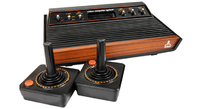Video game crash of 1983
 | |
| Video game crash of 1983 | |
| Impacted | Video game industry |
| Location | Primarily in the United States |
| Date(s) | 1983 - 1985 |
The video game crash of 1983, known in Japan as the Atari Shock, was the second recession in the video game industry in the United States of America. It occurred from 1983 until the market began to recover in 1985.
Cause
It was caused by a multitude of factors, including a lack of quality control in software releases, and an excessive amount of hardware releases.
Another factor was the drop in price of computers, primarily due to a price war between Commodore International and Texas Instruments, which made them as inexpensive as video game consoles. Because computers of the time were more powerful than concurrently released video game consoles, they allowed developers to create more sophisticated games.
Recovery
After the crash, the perception of chain stores toward video games was that they were a fad that ran its course.
To combat this, when Nintendo of America released the Nintendo Entertainment System, a localized version of the Nintendo Family Computer, it redesigned the console to resemble a VCR, which would make it fit in within the entertainment configurations common in American homes at the time.
Nintendo also released a toy robot called R.O.B., or Robotic Operating Buddy. Toy stores that lost money due to unsold video games and consoles were convinced to carry the Nintendo Entertainment System, as well as its games and peripherals, as it was demonstrably different from consoles that had come before.
Gail Tilden, then the head of Nintendo's advertising department, also came up with the term Game Pak to avoid the term ROM cartridge in order to prevent customers being reminded of the video game crash.
To combat the oversaturation that contributed to the crash, Nintendo of America limited the amount of games companies could release per year. It also implemented a strict set of rules by which any company would have to abide to be an official licensee. This included including restricting religious symbols and violence in an attempt to market the console as family-friendly in the region. It also created the "Nintendo Seal of Quality", which would appear on the packaging and Game Pak of officially licensed products.
These efforts proved to be successful. After the release of the NES, the industry ultimately not only recovered, but the userbase expanded. By the 21st century, the video game industry had become the most profitable entertainment industry in North America.